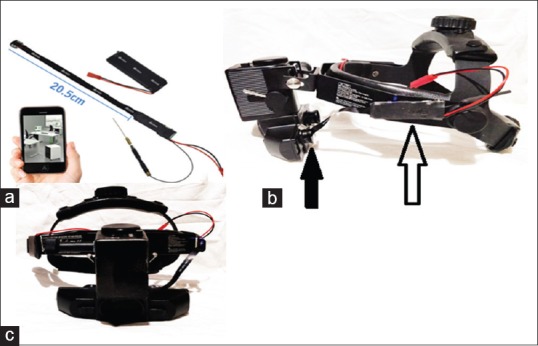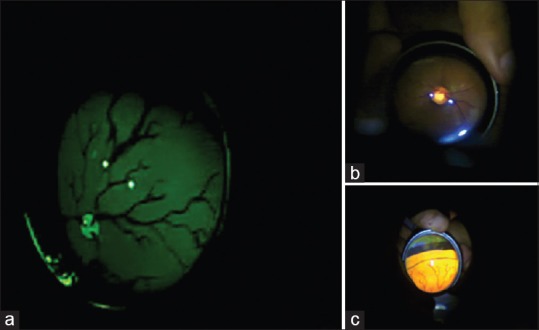In the article entitled, “Smartphone-based evaluation of the optic nerve head,”[1] the authors have described a very unique and a low-cost way of imaging the optic nerve head. Fundus cameras are not used on a large scale in many low socioeconomic countries where screening of eye diseases is restricted due to the higher cost, large size, and difficulty in using the device. Mobile phone-based fundus imaging is gaining popularity due to the improved resolution of the cameras, and lower cost and availability of adapters with lenses, which help capture good resolution images. Peek adapters have been widely used for smartphone-based optic disc imaging in the subsaharan Africa region with an image resolution sufficient to identify the glaucoma suspects.[2] We are moving from an era of bulky equipment that provided lower resolution of fundus images to portable devices, which are giving very good resolution of fundus images at a lower cost.
We have made a prototype of a low-cost video indirect ophthalmoscope (IO) using an IO, telephoto lens and a small spy camera (Mini Wireless HD 1080P SPY Hidden Camera Wifi Module video recorder), which can either be mounted on a uniocular eye piece of the IO or using a beam splitter as well [Fig. 1]. We also used a butter paper over the light source to create a diffuse illumination. We obtained good resolution of images using this technique of the posterior pole as well as the peripheral retina [Fig. 2] and the data can be directly viewed via an application using the smartphone, which can be transferred via Wifi. The device cost is Rs 4,000. We can record high-definition videos or capture still images using this technique.
Figure 1.

(a) Mini wireless HD spy camera. (b) Dark solid arrow indicates the spy camera attached to the indirect ophthalmoscope eye piece, hollow arrow indicates the WiFi device with the antenna attached with a tape. (c) Front view of the indirect ophthalmoscope with the Wifi device
Figure 2.

(a) Red free image of the fundus of a model eye. (b) A normal optic disc imaged in a patient. (c) Peripheral retina imaged in a model eye
Other applications for such retinal imaging would be for training purpose in OPD or in operating rooms in which medical students may view the surgery on a screen through the perspective of the surgeon and an additional advantage is the ability to record audio narration while examining patients.
A device called google glass was launched in the year 2013 for the developers and it was found to have many useful applications in the healthcare sector. Advantages include its head-mounted design and hands-free use.[3] Google glass has also been used for indirect ophthalmoscopy with a small modification of attaching an external illumination source.[4]
In the recent years, the focus is on tele ophthalmology using artificial intelligence to grade fundus images of diabetic retinopathy with good sensitivity and specificity.[5,6] Research work is going on in the area of artificial intelligence to train the computer to analyse the fundus images and help identify glaucoma suspects, age-related macular degeneration, retinopathy of prematurity, Alzheimer's disease, refractive error, gender, age, and patients at cardio vascular disease risk.
The future fundus imaging devices need to be portable and nonmydriatic; provide good resolution of images at a low cost; easy to use; provide wide angle imaging; and maybe with an artificial intelligence to grade fundus images.
Acknowledgement
I thank Dr. Naresh Babu, Head of Vitreo-Retina services at Aravind Eye Hospital, Madurai for the inspiration.
References
- 1.Pujari A, Mukhija R, Chawla R, Phuljhele S, Saxena R, Sharma P. Smartphone-based evaluation of the optic nerve head. Indian J Ophthalmol. 2018;66:1617–8. doi: 10.4103/ijo.IJO_394_18. [DOI] [PMC free article] [PubMed] [Google Scholar]
- 2.Bastawrous A, Giardini ME, Bolster NM, Peto T, Shah N, Livingstone IA, et al. Clinical validation of a smartphone-based adapter for optic disc imaging in Kenya. JAMA Ophthalmol. 2016;134:151–8. doi: 10.1001/jamaophthalmol.2015.4625. [DOI] [PMC free article] [PubMed] [Google Scholar]
- 3.Muensterer OJ, Lacher M, Zoeller C, Bronstein M, Kübler J. Google glass in pediatric surgery: An exploratory study. Int J Surg. 2014;12:281–9. doi: 10.1016/j.ijsu.2014.02.003. [DOI] [PubMed] [Google Scholar]
- 4.Aaron W, Alex C, David LG, Michael XR, Rezaei M, Allen OE. Google glass indirect ophthalmoscopy. J MTM. 2015;4:15–9. [Google Scholar]
- 5.Rajalakshmi R, Subashini R, Anjana RM, Mohan V. Automated diabetic retinopathy detection in smartphone-based fundus photography using artificial intelligence. Eye (Lond) 2018;32:1138–44. doi: 10.1038/s41433-018-0064-9. [DOI] [PMC free article] [PubMed] [Google Scholar]
- 6.Gulshan V, Peng L, Coram M, Stumpe MC, Wu D, Narayanaswamy A, et al. Development and validation of a deep learning algorithm for detection of diabetic retinopathy in retinal fundus photographs. JAMA. 2016;316:2402–10. doi: 10.1001/jama.2016.17216. [DOI] [PubMed] [Google Scholar]


